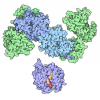+ Open data
Open data
- Basic information
Basic information
| Entry | Database: PDB / ID: 6lnu | ||||||||||||
|---|---|---|---|---|---|---|---|---|---|---|---|---|---|
| Title | Cryo-EM structure of immature Zika virus | ||||||||||||
 Components Components | (Genome polyprotein) x 2 | ||||||||||||
 Keywords Keywords | VIRUS / immature Zika virus / flavivirus | ||||||||||||
| Function / homology |  Function and homology information Function and homology informationflavivirin / symbiont-mediated suppression of host JAK-STAT cascade via inhibition of host TYK2 activity / symbiont-mediated suppression of host JAK-STAT cascade via inhibition of STAT2 activity / symbiont-mediated suppression of host JAK-STAT cascade via inhibition of STAT1 activity / negative regulation of innate immune response / viral capsid / double-stranded RNA binding / nucleoside-triphosphate phosphatase / 4 iron, 4 sulfur cluster binding / mRNA (guanine-N7)-methyltransferase ...flavivirin / symbiont-mediated suppression of host JAK-STAT cascade via inhibition of host TYK2 activity / symbiont-mediated suppression of host JAK-STAT cascade via inhibition of STAT2 activity / symbiont-mediated suppression of host JAK-STAT cascade via inhibition of STAT1 activity / negative regulation of innate immune response / viral capsid / double-stranded RNA binding / nucleoside-triphosphate phosphatase / 4 iron, 4 sulfur cluster binding / mRNA (guanine-N7)-methyltransferase / methyltransferase cap1 / clathrin-dependent endocytosis of virus by host cell / mRNA (nucleoside-2'-O-)-methyltransferase activity / mRNA 5'-cap (guanine-N7-)-methyltransferase activity / molecular adaptor activity / RNA helicase activity / host cell perinuclear region of cytoplasm / protein dimerization activity / host cell endoplasmic reticulum membrane / RNA helicase / symbiont-mediated suppression of host type I interferon-mediated signaling pathway / induction by virus of host autophagy / RNA-directed RNA polymerase / viral RNA genome replication / serine-type endopeptidase activity / RNA-dependent RNA polymerase activity / virus-mediated perturbation of host defense response / fusion of virus membrane with host endosome membrane / centrosome / lipid binding / viral envelope / host cell nucleus / virion attachment to host cell / GTP binding / structural molecule activity / virion membrane / ATP hydrolysis activity / proteolysis / extracellular region / ATP binding / membrane / metal ion binding Similarity search - Function | ||||||||||||
| Biological species |   Zika virus Zika virus | ||||||||||||
| Method | ELECTRON MICROSCOPY / single particle reconstruction / cryo EM / Resolution: 9 Å | ||||||||||||
 Authors Authors | Tan, T.Y. / Fibriansah, G. / Kostyuchenko, V.A. / Ng, T.S. / Lim, X.X. / Lim, X.N. / Shi, J. / Morais, M.C. / Corti, D. / Lok, S.M. | ||||||||||||
| Funding support |  Singapore, 3items Singapore, 3items
| ||||||||||||
 Citation Citation |  Journal: Nat Commun / Year: 2020 Journal: Nat Commun / Year: 2020Title: Capsid protein structure in Zika virus reveals the flavivirus assembly process. Authors: Ter Yong Tan / Guntur Fibriansah / Victor A Kostyuchenko / Thiam-Seng Ng / Xin-Xiang Lim / Shuijun Zhang / Xin-Ni Lim / Jiaqi Wang / Jian Shi / Marc C Morais / Davide Corti / Shee-Mei Lok /    Abstract: Structures of flavivirus (dengue virus and Zika virus) particles are known to near-atomic resolution and show detailed structure and arrangement of their surface proteins (E and prM in immature virus ...Structures of flavivirus (dengue virus and Zika virus) particles are known to near-atomic resolution and show detailed structure and arrangement of their surface proteins (E and prM in immature virus or M in mature virus). By contrast, the arrangement of the capsid proteins:RNA complex, which forms the core of the particle, is poorly understood, likely due to inherent dynamics. Here, we stabilize immature Zika virus via an antibody that binds across the E and prM proteins, resulting in a subnanometer resolution structure of capsid proteins within the virus particle. Fitting of the capsid protein into densities shows the presence of a helix previously thought to be removed via proteolysis. This structure illuminates capsid protein quaternary organization, including its orientation relative to the lipid membrane and the genomic RNA, and its interactions with the transmembrane regions of the surface proteins. Results show the capsid protein plays a central role in the flavivirus assembly process. | ||||||||||||
| History |
|
- Structure visualization
Structure visualization
| Movie |
 Movie viewer Movie viewer |
|---|---|
| Structure viewer | Molecule:  Molmil Molmil Jmol/JSmol Jmol/JSmol |
- Downloads & links
Downloads & links
- Download
Download
| PDBx/mmCIF format |  6lnu.cif.gz 6lnu.cif.gz | 70.8 KB | Display |  PDBx/mmCIF format PDBx/mmCIF format |
|---|---|---|---|---|
| PDB format |  pdb6lnu.ent.gz pdb6lnu.ent.gz | 43.8 KB | Display |  PDB format PDB format |
| PDBx/mmJSON format |  6lnu.json.gz 6lnu.json.gz | Tree view |  PDBx/mmJSON format PDBx/mmJSON format | |
| Others |  Other downloads Other downloads |
-Validation report
| Summary document |  6lnu_validation.pdf.gz 6lnu_validation.pdf.gz | 947.1 KB | Display |  wwPDB validaton report wwPDB validaton report |
|---|---|---|---|---|
| Full document |  6lnu_full_validation.pdf.gz 6lnu_full_validation.pdf.gz | 946.7 KB | Display | |
| Data in XML |  6lnu_validation.xml.gz 6lnu_validation.xml.gz | 30.2 KB | Display | |
| Data in CIF |  6lnu_validation.cif.gz 6lnu_validation.cif.gz | 45.4 KB | Display | |
| Arichive directory |  https://data.pdbj.org/pub/pdb/validation_reports/ln/6lnu https://data.pdbj.org/pub/pdb/validation_reports/ln/6lnu ftp://data.pdbj.org/pub/pdb/validation_reports/ln/6lnu ftp://data.pdbj.org/pub/pdb/validation_reports/ln/6lnu | HTTPS FTP |
-Related structure data
| Related structure data |  0933MC  0932C  0934C  6lntC C: citing same article ( M: map data used to model this data |
|---|---|
| Similar structure data |
- Links
Links
- Assembly
Assembly
| Deposited unit | 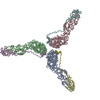
|
|---|---|
| 1 | x 60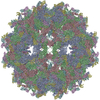
|
| 2 |
|
| 3 | x 5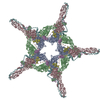
|
| 4 | x 6
|
| 5 | 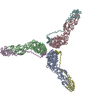
|
| Symmetry | Point symmetry: (Schoenflies symbol: I (icosahedral)) |
- Components
Components
| #1: Protein | Mass: 54444.051 Da / Num. of mol.: 3 / Source method: isolated from a natural source Source: (natural)  Zika virus (isolate ZIKV/Human/French Polynesia/10087PF/2013) Zika virus (isolate ZIKV/Human/French Polynesia/10087PF/2013)Strain: isolate ZIKV/Human/French Polynesia/10087PF/2013 References: UniProt: A0A024B7W1, flavivirin, nucleoside-triphosphate phosphatase, RNA helicase, mRNA (guanine-N7)-methyltransferase, methyltransferase cap1, RNA-directed RNA polymerase #2: Protein | Mass: 18561.266 Da / Num. of mol.: 3 / Source method: isolated from a natural source Source: (natural)  Zika virus (isolate ZIKV/Human/French Polynesia/10087PF/2013) Zika virus (isolate ZIKV/Human/French Polynesia/10087PF/2013)Strain: isolate ZIKV/Human/French Polynesia/10087PF/2013 References: UniProt: A0A024B7W1, flavivirin, nucleoside-triphosphate phosphatase, RNA helicase, mRNA (guanine-N7)-methyltransferase, methyltransferase cap1, RNA-directed RNA polymerase |
|---|
-Experimental details
-Experiment
| Experiment | Method: ELECTRON MICROSCOPY |
|---|---|
| EM experiment | Aggregation state: PARTICLE / 3D reconstruction method: single particle reconstruction |
- Sample preparation
Sample preparation
| Component | Name: Zika virus ZIKV/H. sapiens/FrenchPolynesia/10087PF/2013 Type: VIRUS Details: The virus was isolated from Zika patient. The immature Zika virus was grown in Aedes Albopictus clone C6/36 cell. Entity ID: all / Source: NATURAL |
|---|---|
| Molecular weight | Units: MEGADALTONS / Experimental value: NO |
| Source (natural) | Organism:  Zika virus ZIKV/H. sapiens/FrenchPolynesia/10087PF/2013 Zika virus ZIKV/H. sapiens/FrenchPolynesia/10087PF/2013Strain: H/PF/2013 |
| Details of virus | Empty: NO / Enveloped: YES / Isolate: STRAIN / Type: VIRION |
| Buffer solution | pH: 8 / Details: 10 mM Tris-HCl, 120 mM NaCl, 1 mM EDTA, pH 8 |
| Specimen | Embedding applied: NO / Shadowing applied: NO / Staining applied: NO / Vitrification applied: YES Details: the virus sample was incubated at 37deg C for 30 min prior to sample blotting onto the grid. |
| Vitrification | Cryogen name: ETHANE |
- Electron microscopy imaging
Electron microscopy imaging
| Experimental equipment |  Model: Titan Krios / Image courtesy: FEI Company |
|---|---|
| Microscopy | Model: FEI TITAN KRIOS |
| Electron gun | Electron source:  FIELD EMISSION GUN / Accelerating voltage: 300 kV / Illumination mode: SPOT SCAN FIELD EMISSION GUN / Accelerating voltage: 300 kV / Illumination mode: SPOT SCAN |
| Electron lens | Mode: BRIGHT FIELD / Nominal magnification: 59000 X / Nominal defocus max: 3500 nm / Nominal defocus min: 500 nm / Cs: 2.7 mm |
| Image recording | Electron dose: 18 e/Å2 / Film or detector model: FEI FALCON II (4k x 4k) |
- Processing
Processing
| EM software |
| |||||||||||||||||||||||||||||||||||||||||||||
|---|---|---|---|---|---|---|---|---|---|---|---|---|---|---|---|---|---|---|---|---|---|---|---|---|---|---|---|---|---|---|---|---|---|---|---|---|---|---|---|---|---|---|---|---|---|---|
| CTF correction | Type: PHASE FLIPPING ONLY | |||||||||||||||||||||||||||||||||||||||||||||
| Symmetry | Point symmetry: I (icosahedral) | |||||||||||||||||||||||||||||||||||||||||||||
| 3D reconstruction | Resolution: 9 Å / Resolution method: FSC 0.143 CUT-OFF / Num. of particles: 7922 / Symmetry type: POINT | |||||||||||||||||||||||||||||||||||||||||||||
| Atomic model building | Protocol: FLEXIBLE FIT | |||||||||||||||||||||||||||||||||||||||||||||
| Atomic model building | PDB-ID: 4B03 Accession code: 4B03 / Source name: PDB / Type: experimental model |
 Movie
Movie Controller
Controller






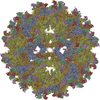
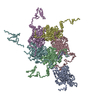
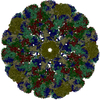
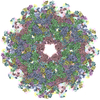
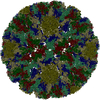
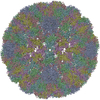
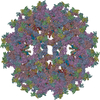
 PDBj
PDBj

